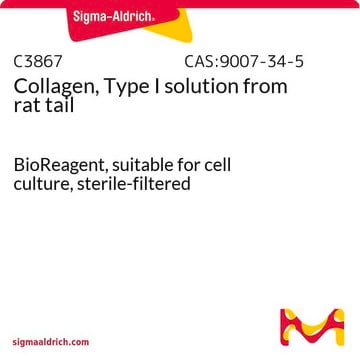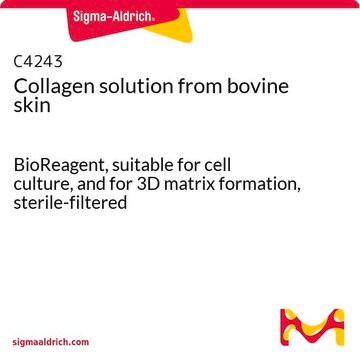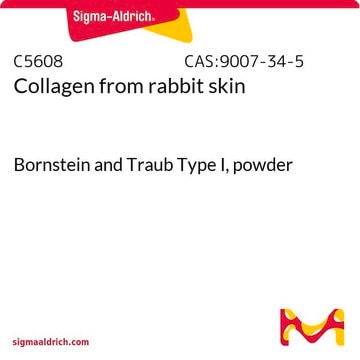5162
Bovine Collagen Type I
from bovine flexor tendon, powder, suitable for cell culture, used for 3D gel formation
Synonym(e):
Collagen Protein, Collagen Solution, Collagen Type I
Größe auswählen
About This Item
Empfohlene Produkte
Produktbezeichnung
Kollagen, from bovine flexor tendon
Biologische Quelle
bovine flexor tendon
Sterilität
non-sterile
Assay
>96%
Form
lyophilized powder (fibrous)
Verpackung
pkg of 1 g
Methode(n)
cell culture | mammalian: suitable
UniProt-Hinterlegungsnummer
Bindungsspezifität
Peptide Source: Elastin
Peptide Source: Fibronectin
Peptide Source: Laminin
Versandbedingung
wet ice
Lagertemp.
room temp
Angaben zum Gen
bovine ... COL2A1(407142)
Allgemeine Beschreibung
This collagen product is naturally cross-linked yielding a robust material for applications which require structure and strength. This product can be readily prepared into such forms as tissue scaffolds, foams, sponges, suspensions, coatings, putties, films and sheets but does not form hydrogels. Using typical cross-linking methods, this material can be tuned for optimal in vivo resorption. This collagen product is ideal for tissue engineering applications and uses with inorganic and biomaterials.
The product is provided in user-friendly packaging for use and storage. Avoid extended exposure to ambient environment since this material is hygroscopic.
Angaben zur Herstellung
Note: The following procedure is based on solubilization of 1 gram of collagen in 100 ml to initially prepare a 10 mg/ml collagen suspension. Smaller quantities and volumes may be used but the same ratios of collagen and solutions should be used.
1. Weigh out 1 gram of collagen fibrous powder.
2. Reconstitute 1 gram of collagen with 50 ml of cold purified water (50% of the final volume).
3. Stir the collagen with the water continuously mixing for a minimum of 15 minutes until the collagen is fully wetted and the suspension appears to be a semi-solution.
4. Add 50 ml of cold 0.02 M HCl to the collagen mixture and stir for a minimum of 10 minutes. This will yield a collagen concentration of 10 mg/ml with the suspension continuing to appear as a semi-solution.
5. Measure the pH - the mixture should have a pH of 2 to 3.
6. Using Waring stick blender or equivalent, homogenize the collagen mixture for a minimum of 15 minute at a high speed ensuring that the collagen is fully homogenized. Ensure that the temperature of mixture does exceed 24°C. Upon completion, there should be no visual solids in the viscous suspension. Air bubbles with be prevalent.
7. To remove air bubbles, stir the solution on a stir plate and pull a vacuum on the suspension. This will remove the air bubbles.
8. At this point if a collagen concentration of less than 10 mg/ml is desired, the collagen can be diluted with 0.01 M HCl.
Lagerklassenschlüssel
11 - Combustible Solids
WGK
WGK 1
Flammpunkt (°F)
Not applicable
Flammpunkt (°C)
Not applicable
Hier finden Sie alle aktuellen Versionen:
Besitzen Sie dieses Produkt bereits?
In der Dokumentenbibliothek finden Sie die Dokumentation zu den Produkten, die Sie kürzlich erworben haben.
Kunden haben sich ebenfalls angesehen
Aktive Filter
Unser Team von Wissenschaftlern verfügt über Erfahrung in allen Forschungsbereichen einschließlich Life Science, Materialwissenschaften, chemischer Synthese, Chromatographie, Analytik und vielen mehr..
Setzen Sie sich mit dem technischen Dienst in Verbindung.









